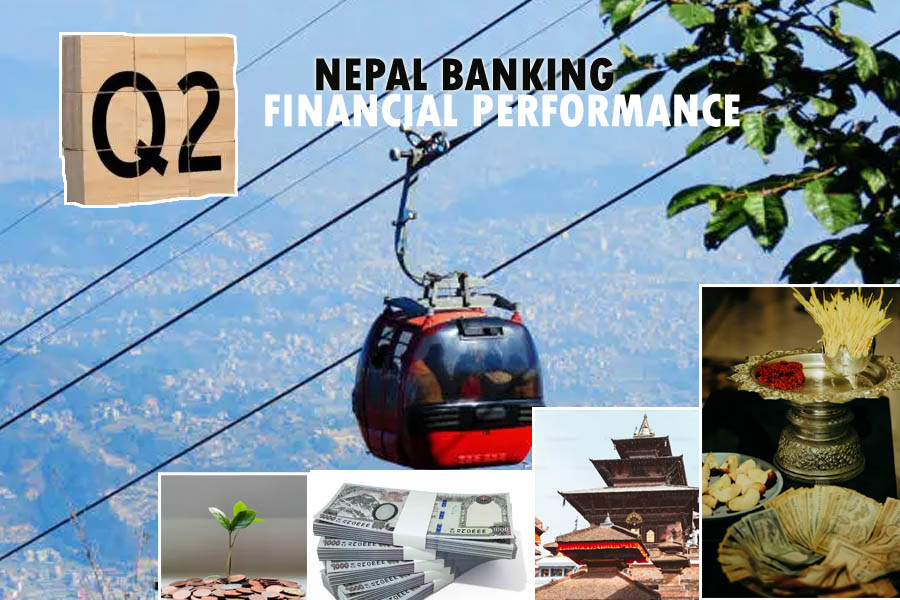
Nepal Banks' Quarterly Report: First Six Months of FY 2081/82
January 20, 2025The first six months of Nepal's fiscal year 2081/82 have revealed promising developments in the banking sector, signaling positive economic growth despite subdued credit lending activity. The banks' financial performance highlights resilience amidst market challenges, and the stock market shows potential for growth. Here's an in-depth look at the financial achievements and challenges faced by key banks in Nepal during this period.
Sector Highlights: Banking and Economic Growth
Economic Momentum: Despite global economic headwinds, Nepal's banking sector indicates robust progress. Increased fee-based income and cost management strategies have helped banks maintain profitability even as credit lending awaits a surge.
Stock Market Outlook: Nepal's stock market is expected to grow moderately, driven by improved financial statements from key players in the banking sector. However, room for expansion remains limited due to cautious investor sentiment.
Bank-Wise Financial Performance
Nabil Bank: Moderate Growth Amid Declining Interest Income
Net Profit: Rs 3.25 billion (up marginally from Rs 3.2 billion last year).
Interest Income: Rs 7.89 billion (down 4.21% YoY).
Fee and Commission Income: Increased by 1.82% to Rs 1.51 billion.
Earnings Per Share (EPS): Increased by 23.74 paisa to Rs 24.05.
Analysis: Nabil's reliance on diversified income streams helped offset the decline in interest income, showcasing its adaptability to market dynamics.
Everest Bank: Robust 21% Profit Growth
Net Profit: Rs 2.07 billion (up from Rs 1.71 billion last year).
Interest Income: Increased by 19%.
Fee and Commission Income: Increased by 14.46%.
Impairment Charges: Reduced to Rs 350 million (from Rs 430 million).
EPS: Rs 32 (up from Rs 18).
Analysis: Everest Bank's efficient cost management and diversified revenue sources solidify its competitive positioning in the market.
Prabhu Bank: Remarkable 84% Profit Growth
Net Profit: Rs 1.34 billion (up from Rs 720 million last year).
Impairment Charges: Reduced to Rs 810 million (from Rs 1.26 billion).
EPS: Rs 11; PE ratio declined to 19.36.
Distributable Profit: Negative Rs 3.33 billion, reflecting underlying challenges in liquidity management.
Analysis: Despite impressive profit growth, Prabhu Bank's negative distributable profit raises concerns about sustainability and capital adequacy.
Himalayan Bank: Steady Growth
Net Profit: Rs 1.51 billion (up from Rs 1.50 billion last year).
Net Interest Income: Increased to Rs 5.82 billion.
Loss Provisions: Reduced to Rs 1.88 billion (from Rs 1.94 billion).
EPS: Rs 14.
Analysis: Himalayan Bank's stable performance highlights effective cost management and reduced risk provisions.
NIC Asia Bank: Sharp Profit Decline
Net Profit: Rs 151.7 million (down from Rs 1.9 billion last year).
Loan Loss Provision: Increased sharply to Rs 2.35 billion (from Rs 480 million).
EPS: Declined to Rs 2.3 paisa (from Rs 25.59 paisa).
Non-Performing Loans (NPL): Increased to 1.47% (from 0.58%).
Analysis: NIC Asia's profitability was significantly impacted by a surge in loan loss provisions, highlighting a need for improved risk assessment and management.
Krishi Bikas Bank: Decline in Profitability
Net Profit: Rs 957 million (down 29% YoY).
Interest Income: Fell to Rs 3.48 billion (from Rs 4.48 billion).
NPL: Increased to 4.9% (from 3.02%).
Analysis: Krishi Bikas Bank's focus on agricultural financing underscores the challenges of lending in high-risk sectors.
Nepal Investment Mega Bank (NIMB): Strong Profit Growth
Net Profit: Rs 2.83 billion (up 57% YoY).
Net Interest Income: Declined by 2.37% to Rs 7.36 billion.
Impairment Charges: Reduced to Rs 1.77 billion (from Rs 2.86 billion).
EPS: Rs 16.60 (up Rs 6.4 YoY).
Analysis: NIMB's profitability reflects improved operational efficiency and reduced provisioning costs.
Lakshmi Sunrise Bank: Marginal Growth
Net Profit: Rs 1.16 billion (up 10% YoY).
EPS: Rs 9.55 (up from Rs 9.14).
NPL: Increased to 2.11%.
Analysis: Lakshmi Sunrise Bank's focus on minimizing impairment charges contributed to steady profit growth.
Machhapuchhre Bank: Marginal Profit Growth
Net Profit: Rs 807.3 million (up from Rs 805.3 million last year).
NPL: Increased to 4.54% (from 2.6%).
Analysis: While profits remained steady, rising bad loans highlight potential challenges ahead.
Overview of Nepal Banks' Performance
The banking sector's performance underscores Nepal's economic recovery and resilience. Despite challenges like declining interest incomes and rising NPLs in some banks, efficient cost management and diversified income streams have driven profitability. With expectations of improved credit activity in the coming quarters, the sector is poised for moderate growth.
In the first half of the current fiscal year, the commercial banking sector in Nepal has experienced a negative profit growth rate of 4.36%, reflecting a decrease in net profit compared to the same period last year. The decline in interest income, an increase in bad loans, and the rising provisions for loan defaults have all contributed to the negative financial performance. The total net profit of the 20 commercial banks for the period stands at 27.43 billion rupees, down from 28.68 billion rupees in the previous fiscal year.
Out of the 20 commercial banks, 9 have reported a decline in profits, while 11 banks have seen an increase. Experts attribute the decline to ongoing challenges within the economy, including payment delays among construction entrepreneurs and the strain on small and medium enterprises. The banking sector is grappling with difficulties in loan recovery and overall business operations, further impacting profitability.
Leading Performers
Among the top performers, Nabil Bank emerged as the most profitable with a net profit of NPR 4.08 billion, followed by Rastriya Banijya Bank at NPR 3.80 billion. Global IME Bank and NIC Asia Bank also demonstrated strong performances with net profits of NPR 3.54 billion and NPR 3.39 billion, respectively.
Non-Performing Loans (NPL) and Challenges
Despite the profit growth, challenges persist in the sector. The average Non-Performing Loan (NPL) ratio rose to 2.89%, up from 2.58% in the previous year, signaling growing concerns over loan quality and recovery. Banks are under increasing pressure to manage credit risks effectively while maintaining profitability.
Market Expansion
The banking sector has seen a significant rise in total deposits, which increased by 10.78% to NPR 5,570 billion. Loan disbursements grew by 8.96%, reaching NPR 5,145 billion by the end of the review period. This indicates sustained confidence among depositors and borrowers alike.
Capital Adequacy
All commercial banks have successfully maintained their Capital Adequacy Ratios (CAR) above the regulatory requirement of 11%. This underscores the sector's resilience and ability to withstand financial shocks.
Looking Ahead
Nepal's banking sector has demonstrated resilience, with a mix of strong performers and areas requiring improvement. As the country looks to accelerate economic activities, the banking sector's stability and growth will play a pivotal role in driving Nepal's financial and economic prospects.
The second half of FY 2081/82 is expected to be equally dynamic as banks focus on improving asset quality, reducing NPL ratios, and diversifying their investment portfolios. While profit growth has been steady, the sector must navigate macroeconomic uncertainties and regulatory pressures to sustain its performance.
Source: Financial Reports of Commercial Banks in Nepal
Nepal Banks' Quarterly Report: Financial Status for the First Half
The first six-month financial reports from Nepalese banks indicate promising growth trends. While challenges persist, the Nepal Stock Market shows potential for further growth.
Let’s dive into the performance of Nepalese banks during the first half of the fiscal year 2081/2082.
Subscribe for UpdatesJoin our growing community for timely updates.
Read More From Us
- 🌟🌟🌟🌟🌟 For more International Breaking News visit us at International News
- 🌟🌟🌟🌟 For More Russia-Ukraine War updates, click here
- 🌟🌟🌟🌟🌟 For more International Trade Business news, hit here
Tags:#NepalBanking #FinancialPerformance #StockMarketUpdate #NepalEconomy #BankingTrends #QuarterlyReports #FiscalYear2081 #EconomicGrowth #BankingInsights #NepalFinance #GlobalPostHeadline
Thank you for reading: globalpostheadline.com





